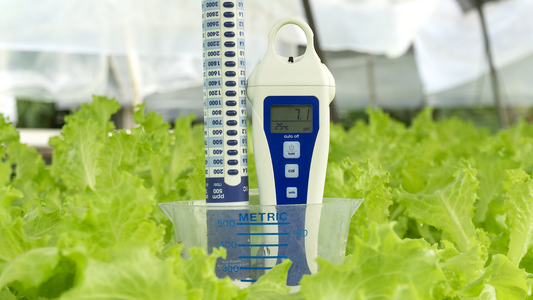Discover the essential role of pH and acidity in plant growth, nutrient uptake, and soil health. Learn the ideal pH range for plants, common issues caused by pH imbalance, and effective ways to correct acidity in your garden.
Quick Links
- What is Acidity?
- Understanding pH
- Ideal pH Levels for Plants
- Why Acidity Matters for Plant Growth
- Signs of Incorrect pH Levels in Soil
- What Determines pH?
- How Plants Influence Acidity
- Measuring pH
- Correcting pH Levels
What is Acidity?
Acidity is essential for life on Earth, as it influences characteristics like quality, absorbability, and solubility in substances. Enzymes, responsible for almost all biological processes, only function within specific acidity ranges. Even slight changes in acidity can have dramatic effects, impacting everything from enzyme function to nutrient solubility.
Understanding pH
The term pH, derived from "pondus Hydrogenii," measures a solution's acidity or alkalinity. The pH scale ranges from 0 to 14:
- 0 - 7: Acidic (e.g., vinegar, cola)
- 7: Neutral (e.g., pure water)
- 7 - 14: Alkaline (e.g., soda, soap)
The pH of water can vary depending on dissolved substances. For example, pure water at room temperature has a pH of 7, but tap water often has a slightly higher pH due to calcium content.
Ideal pH Levels for Plants
Most plants thrive in mildly acidic conditions, typically between a pH of 5 and 6.5. Many natural environments, including soil, have a similar pH range, which helps plants absorb nutrients more effectively. In fact, some plant experts consider a pH of 5.5 as "neutral" for plant growth due to its commonality in nature.
Why Acidity Matters for Plant Growth
Acidity directly impacts the availability and solubility of essential nutrients. If the pH is too high or too low, plants may struggle to absorb nutrients, leading to deficiencies and growth problems. Acidity also affects soil structure, organic breakdown, and microbial activity, all of which are crucial for plant health.
Key Influences of pH on Plant Growth:
- Solubility of nutrients
- Microbial life in the soil
- Soil structure and organic breakdown
- Leaching of nutrients, pesticides, and metals
Signs of Incorrect pH Levels in Soil
Low pH in Soil
- Excessive solubility of manganese, aluminum, and iron
- Deficiencies in phosphorus, potassium, magnesium, and molybdenum
- Inhibited soil life and poor soil structure
- Magnesium deficiency in cold soils
High pH in Soil
- Reduced solubility of calcium, iron, and phosphate
- Deficiencies in manganese, iron, copper, zinc, and boron
- Increased organic breakdown in sandy soils
What Determines pH?
The pH of water or soil is heavily influenced by its buffering capacity, which refers to the solution's ability to resist pH changes. For example, adding a drop of acid to 1 litre of tap water with a pH of 7 will have a minor impact, thanks to the bicarbonate content. However, the same drop in demineralised water would cause a dramatic pH drop.
How Plants Influence Acidity
Plants have a unique ability to alter the acidity around their roots. Depending on the growth phase, nutrient availability, root temperature, and light intensity, plants secrete either acidic or alkaline substances. This fluctuation in root environment pH affects nutrient uptake and can change based on environmental factors.
Other Influences on Root Environment Acidity:
- Microbial activity
- CO₂ levels
- Algae growth
Measuring pH
Measuring pH is straightforward with the right tools. Litmus paper and pH testing kits offer affordable, albeit less precise, solutions, while pH meters provide greater accuracy. Regular calibration is essential for accurate readings with pH meters.
Taking Accurate pH Samples
- In recirculating systems, measure the feeding solution’s pH.
- In substrate systems, take samples from several locations around the root zone, such as under and around drippers.
- In soil, coco, and peat substrates, collect samples from multiple areas to get an average reading.
Correcting pH Levels
If the root environment has a pH between 5 and 6.4, no immediate correction is necessary. However, if the pH drops below 5 or rises above 6.4, gradual adjustments are advisable.
How to Adjust pH Levels:
- Lowering pH: Use nitric acid during the growth phase and phosphoric acid during the flowering phase.
- Raising pH: Apply caustic potash, potassium bicarbonate, or soda sparingly.
Pro Tip: Record your pH measurements over time to understand trends and make informed adjustments. Monitoring pH helps maintain stability in the root environment, promoting healthy plant growth.
Frequently Asked Questions
- Why is pH important for plants? pH affects nutrient availability, microbial activity, and root health, making it crucial for optimal plant growth.
- What is the ideal pH for plant growth? Most plants thrive at a pH between 5 and 6.5, which maximizes nutrient availability.
- How can I adjust the pH in my garden? Use specific acids to lower pH or alkaline substances to raise it. Adjust gradually to avoid stress on plants.





